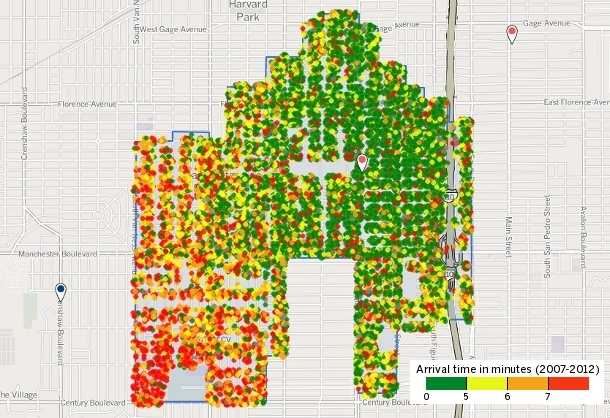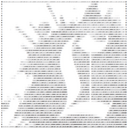Inside our 911 response time analysis
How The Times analyzed public records to identify a systematic weakness at the Los Angeles city border.

The Los Angeles Fire Department rarely reaches across jurisdictional lines for help, resulting in slower response times for people who live near the city border, according to a story published Saturday by The Times.
The data analysis at the heart of the article has three core findings:
- The LAFD response to medical calls is slower near the city border, where responses are more likely to run extremely long.
- There are many calls near the edge of Los Angeles where Los Angeles County Fire Department stations on the other side of the border are closer to the caller.
- Despite that fact, the county Fire Department is rarely called upon to cross the border into the city.
Below is a walkthrough of how The Times arrived at each conclusion.
The sample: LAFD’s dispatch database
The LAFD maintains an internal database that logs activity in its 911 dispatch center. Known as the CAD database, it is one part of an automatic dispatching system that, at the push of a button, determines the LAFD units closest to a caller and routes them to the scene.
Because the database is owned by a public agency, it is a public record according to the California Public Records Act. The Times acquired it by making a request under that law.
The database contains a set of timestamps for every 911 call handled in the dispatch center and every LAFD unit that moves in the field. That includes the time a call is answered, the time units are dispatched, and the time each unit arrives at the scene.
Because the LAFD sends help to hundreds of calls each day, it adds up to a lot of data. All together, the extract of all activity between Jan. 1, 2007, and March 26, 2012, released to The Times fills 42,690,050 rows. You can a read a fuller description of its structure in this LAFD memo obtained by The Times.
Before the data could be analyzed, some cleaning was necessary. A flaw in how the LAFD system operates causes the database to frequently misrepresent important benchmarks, like when units are dispatched or when the first unit arrives on the scene. The correct timestamps do exist in the database, but a series of computer programming manuevers must to be made to recalculate the essential numbers.
The Times analysis was limited to medical calls for help that opened with a 911 call and resulted in units being sent to the scene. This excluded calls that came in via other routes, like fire alarms, and those that never resulted in a rescuer being dispatched.
The Times also excluded outliers where the data were nonsensical, like when the dispatch time was recorded as having happened in fewer than zero seconds. Also excluded were outliers in which benchmarks were so far apart they suggest the data may be faulty, like records showing the dispatch center took more than 10 minutes to send help or that the first unit took more than 30 minutes to arrive.
Earlier this year, The Times used this same method to analyze how long, on average, it takes LAFD dispatchers to process a call and send help. The resulting story reported that the department lags well behind national standards and it linked slow times to several deaths. The LAFD did not dispute those statistics, and they were later confirmed independently in a separate study conducted by professional auditors at the Los Angeles city controller’s office.
Finding 1: Fringes of the city get slower service
Each 911 response in the LAFD database includes the address where units were sent. For this analysis, The Times used a computerized technique to attempt to convert each address into a pair of latitude and longitude coordinates that could be placed on a map.
The Times was able to map 98.3% of the 442,338 distinct addresses that occurred in the LAFD database. Among those left unmapped, and therefore excluded from this analysis, were 911 calls that sent help to Los Angeles freeways. Those locations could not be mapped because they were recorded in LAFD jargon that The Times was unable to decode.
With all that done, the database was prepared to answer the question: How fast does LAFD respond to calls near the city border compared with the city as a whole? Here is the answer as reported in Saturday’s story:
911 callers within a quarter mile of the city border are nearly 50% more likely to wait more than 10 minutes for rescue crews to arrive.
This comparison required The Times to calculate two numbers.
First, the percentage of all LAFD responses that took longer than 10 minutes, which is well beyond the formal national standard and a rough benchmark for slow responses used by people in the field who were interviewed by The Times. Using the full set of medical calls from the sample described above, The Times found that roughly 10% of LAFD responses took longer than 10 minutes from the moment a dispatcher picks up the line until the first unit arrives on the scene.
Second, The Times calculated that same figure for the subset of medical calls made from addresses within a quarter mile of the city’s jagged border, which were identified by using geospatial software. In those areas, approximately 15% of responses took longer than 10 minutes.
Fifteen is 50% more than 10, so a response to an address within a quarter mile of the border is 50% more likely to take longer than 10 minutes.
Finding 2: County stations are often closer
A second claim in the story asserted:
In more than 70,000 medical calls, LAFD sent rescuers to locations where county firehouses were closer, the analysis found. More than 1,300 of those cases were cardiac arrests, where delays of seconds can be critical because irreversible brain damage can begin just four minutes after the heart stops beating.
This was established by mapping the location of all LAFD and county firehouses and then conducting a geographic analysis that, one by one, examined each response in the LAFD’s dispatch database to determine the station closest to each caller.
In total, 73,836 addresses needing a medical response were found to have a county station closer than the LAFD firehouses that responded.
The LAFD’s database categorizes each medical incident, sorting out strokes, car accidents and other types. Cardiac arrests are one of the most time-sensitive categories. The 73,836 calls identified above were further filtered down to just the subset of cardiac arrests, as defined by LAFD dispatchers. That yielded a total of 1,399, the number cited in the story.
Finding 3: County help rarely comes across the border
A final claim from the story:
Over the last five years, when county fire stations were closer, LAFD dispatchers called county rescuers in less than 10% of emergency medical cases, according to the Times analysis, which included both agencies’ dispatch records.
This was established by examining data from a different source: the Los Angeles County Fire Department. The LAFD does call in the county Fire Department for help in some cases, and the county keeps a log of every run.
Just like the LAFD’s dispatch database, the county’s systems are also a public record. So, The Times acquired the complete list of more than 11,000 county responses into city territory during the same five-year period as the database extract released by the LAFD.
Because the city and county call centers use different computer systems, it is difficult to conduct a thorough analysis of how the two departments interact. There is no common identifier linking individual responses, and each side uses a different system for categorizing incidents.
Plus, according to county Battalion Chief Jon O’Brien, many of the county responses in Los Angeles are on city beaches where county lifeguards hold primary responsiblity, unlike medical 911 calls, where LAFD has jurisdiction.
The Times was able to exclude more than 4,800 beach responses from the county list by mapping those incidents in the same manner as LAFD records and then filtering out those that took place on beaches.
Fewer than 7,000 county responses remained, which is less than 10% of the 73,836 city incidents The Times identified as having a county station closer than the LAFD firehouses that sent help. That is the source of the figure cited above.
Much respect due
This analysis would not have been possible without the help of a number of knowledgable sources both inside and outside of local government. It was also dependent on California’s excellent public records law. Finally, there is no way a hack like me could have accomplished it without stupendous open-source software tools like PostGIS and GeoDjango.





